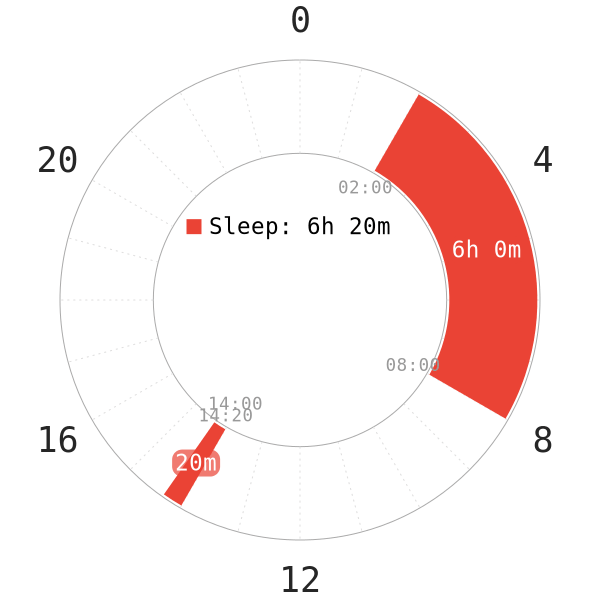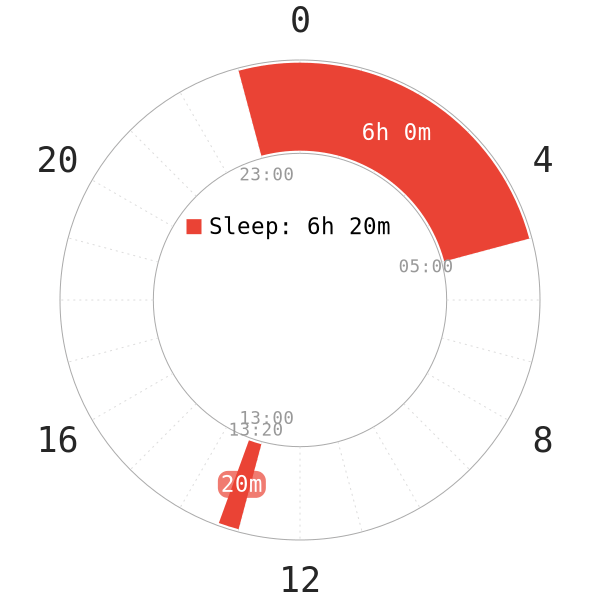
Everyman 1 is often mistaken for the first schedule in the Everyman line. However, it is a biphasic pattern because it only has 1 nap and overall 2 sleep blocks per day. It is an alternative Biphasic schedule with a short nap rather than a longer one as in Siesta sleep. Given some sleep reduction, it is a more advanced biphasic schedule than the regularly non-reducing biphasic/siesta in the world.
Content
- History
- Adaptation
- Difficulty
- Alternate Variants
- Lifestyle Considerations
History
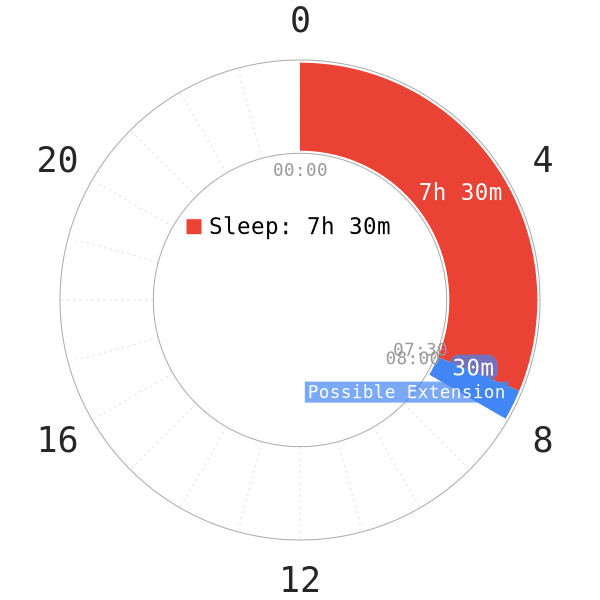
As part of the Formula in Ubersleep, Everyman 1 is part Everyman and part Biphasic. Puredoxyk postulated that each full cycle of a core sleep is equivalent to a nap full of REM. First, assume a 7.5-8h monophasic baseline. Then, a daytime nap’s addition compensates for the reduction of 90m from the monophasic core sleep. The purposes are to:
- Give REM sleep in the nap (ideally)
- Ease new polyphasic sleepers into daytime napping.
Sleep deprivation will accumulate and increase the napping efficiency. This napping method is likely easier than on a non-reduced Biphasic schedule (e.g, Biphasic-X); there is more sleep pressure from a shorter core sleep than from a non-reduced equivalent.
Adaptation
Since Everyman 1 does offer a fair amount of sleep, it is then straightforward to do the cold turkey adaptation method. However, learning to nap on Everyman 1 may take up to several weeks compared to other reduced schedules.
A lot of people are used to sleeping monophasically for only 6h a night, due to work, stress, etc. They can “survive” without the nap. Consequently, reduced monophasic sleep leads to chronic sleep deprivation if their monophasic baseline is higher. Thus, for these cases it will take time for sleep pressure to build to facilitate napping.
However, certain sleepers can fall asleep in the nap after only a matter of days on the schedule. Individuals capable of doing this are usually experienced polyphasic sleepers or nappers. They are able to fall asleep during the day naturally without any sleep deprivation.
With some sleep reduction, Everyman 1 follows the same rules as any other reducing polyphasic schedules. There are exceptions, however. Usually, the total sleep on E1 (6.3h) is a benchmark for measure.
- If it is approximately the same as personal monophasic baseline, these individuals can then proceed to have a regularly flexible nap.
- A somewhat flexible core sleep from day to day is also possible.
- They also wouldn’t need to stick to the sleep times by the minute during adaptation.
Difficulty
Everyman 1 looks to be a straightforward biphasic schedule for beginners; however, the adaptation results from E1 over the years do not reflect the true difficulty level. There have been many reported problems that prevented beginners from adapting fully. These problems persist even after many weeks on the schedule.
Basic Issues
- inability to fall asleep in the nap at all
- feeling excited or stressed before the nap
- high sleep onset for the nap
- consistently oversleeping the nap. These sleepers may have a stronger tendency for a daytime core rather than a short nap
The culprits behind the dragged-out adaptations are:
- Sleep debt prior to starting adaptation
- Poor discipline
- Poor alarm system
- Wrong assessment of personal monophasic sleep need
- Poor diet or food choice that tampers with sleep quality (e.g, too much sugar)
Advanced Issues
- BRAC: The failure to nap after several weeks (despite strictly sticking to sleep times) can result from misaligned BRAC application. Sleep pressure on a biphasic schedule is generally lower than on other schedules with less total sleep. Thus, there are not many choices to pick nap times across many hours in the day; the body may only feel the tiredness and drowsiness at some spots in the day.
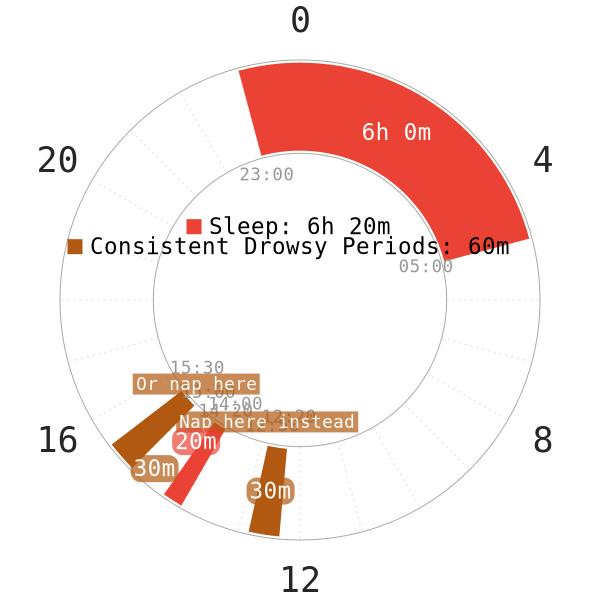
- For example, a nap is at 2 PM; the Everyman 1 sleeper keeps feeling tired and very drowsy around ~12:30 PM or ~3 PM everyday. He has been trying to consistently nap at 2 PM after several weeks as well.
- The solution is to nap at either ~12:30 PM or 3 PM instead.
- Stage 4 loop: Probably the most devastating issue for beginners. This phenomenon typically happens when a sleeper cannot complete the adaptation and get stuck in Stage 4. The Stage 4 trap is likely a result of missing some vital sleep stages (typically REM sleep); the nap fails to give consistent REM sleep, or no REM sleep at all.
According to the Polyphasic Survey 2018, only 50% of ADAPTED E1 sleepers managed to get REM in their nap. This result demonstrates that the sole afternoon nap does not guarantee REM sleep (trace SWS, or mostly light sleep instead). The idea can explain the incomplete repartitioning of REM sleep and the failure to obtain a sufficient amount of REM sleep each day.
Based on the data, it is still possible to complete the adaptation to Everyman 1 with no REM in the nap. The overall time it takes to adapt to E1 is anywhere between 4 and 10 weeks. With all the available information, E1’s difficulty is now “Moderate” as opposed to “Easy” to reflect a more accurate picture.
If the adaptation to E1 is complete after a reasonable amount of time (within 2 months), it is possible to proceed to E2 and E3. These schedules are parts of the Everyman line, with each added nap for a 90m core reduction.
Alternate Variants
With the common trend to schedule the Everyman 1 core at 11 PM or midnight-ish (with good management of dark period, food and exercise), E1 is quite versatile in scheduling. A couple E1 sleepers have succeeded and even maintained a lot of these variations for an extended period of time.
Some of them still remain on the schedule after at least 1 year. It is wise to consider these options before deciding on which variant to try.
Late Nap
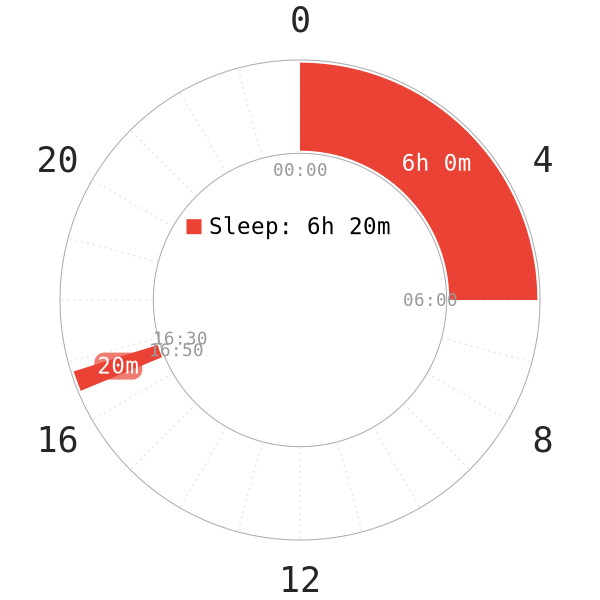
For 9-to-5 occupations, which are very common nowadays and do not allow any naps during lunch breaks, it is possible to schedule this E1 variant with a nap after work (~4-5 PM) and a core around midnight or slightly later. However, there has been less success with the variant.
- The late nap has a low chance to give REM sleep.
- The long wake period from the core to the nap can be tiresome during adaptation.
Overall, the adaptation can therefore be harder than normal. However, an early riser can still take advantage of the distribution of sleeps presented.
Late Core
- Sleepers with less SWS requirement and somewhat higher REM requirement may benefit from it.
- Those who prefer some evening social time or are often alert at late hours can also schedule this variant.
- Some hours of the core are now in REM peak, which will boost the amount of REM gained during these morning hours. The nap is ~6-7h after the core like in the default variant, but should not be too late (after 6 PM).
6.5h Core
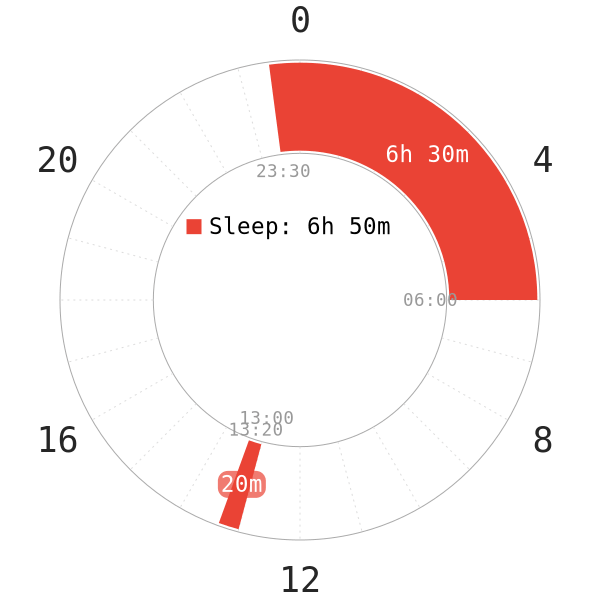
Recently, a new core length variant (6.5h core) has been delivering solid adaptation results. The basis behind this variant is the same as the default equivalent; one full cycle is removed from an 8h monophasic baseline with the addition of a nap.
There has also been a successful story with a physically active lifestyle. However, only few sleepers have decided on this variant. A couple things to note:
- SWS mostly occurs in the first half of the night.
- REM dominates the second half, so there should be ideally no SWS after 6h mark. More REM sleep and/or NREM2 can repartition into the core this way. The potential addition boosts alertness and provides a better opportunity to match personal REM requirement.
- Similar to a 5h core (seen on Siesta and some Everyman variants), the 6.5h core is also a statistically likely REM period.
The following cases can take advantage of the 6.5h core:
- Individuals with slightly higher REM sleep than usual (> 100m each day) can attempt this variant.
- People with overall somewhat higher sleep need.
- A 6.5h core is also a strong compromise between the tricky 6h core and the lengthy 7.5h core. The nap here can be later, because the extra sleep sustains more alertness than a 6h core.
However, like other variants, the nap should not be later than 5-6 PM; the community still needs more data samples for this E1 variant to discover its potential weaknesses.
Early Core
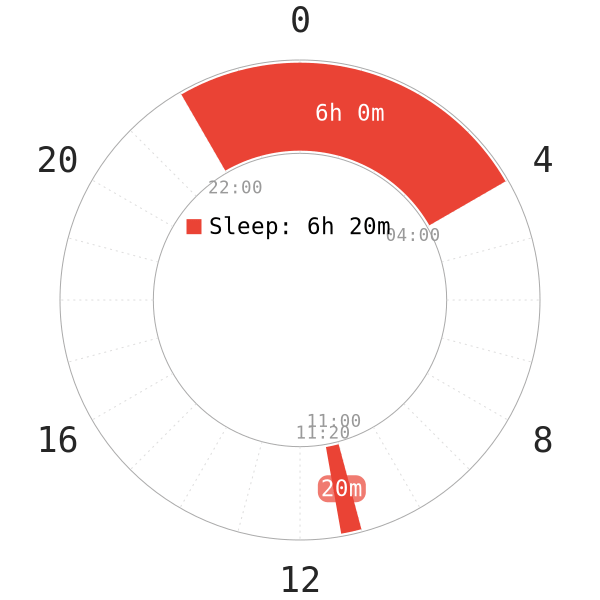
- Contrary to the early core version, those with a tendency to sleep early as a long-term habit can place the core around the late evening hours, initiating sleep time early.
- The nap will then be shifted to earlier hours than in the standard version.
- Sleepers with high SWS requirement can also utilize this distribution.
- The earlier nap can also give more REM sleep thanks to the early daytime hours.
However, this scheduling option has limited usage because most people prefer to dedicate the evening hours to other social activities.
E1-shortened
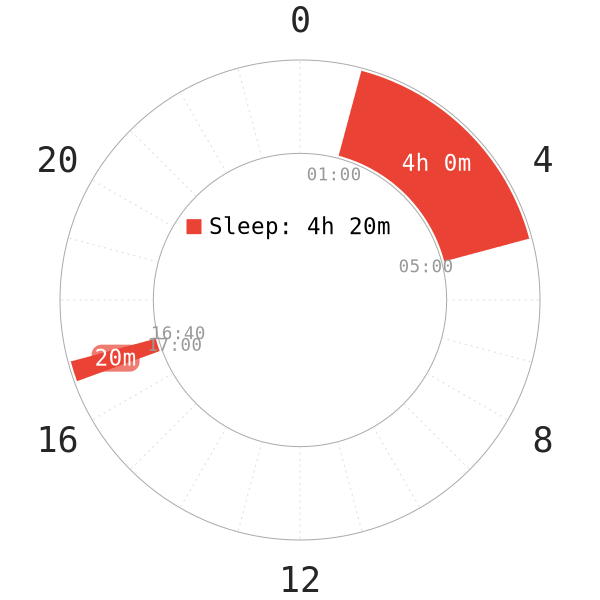
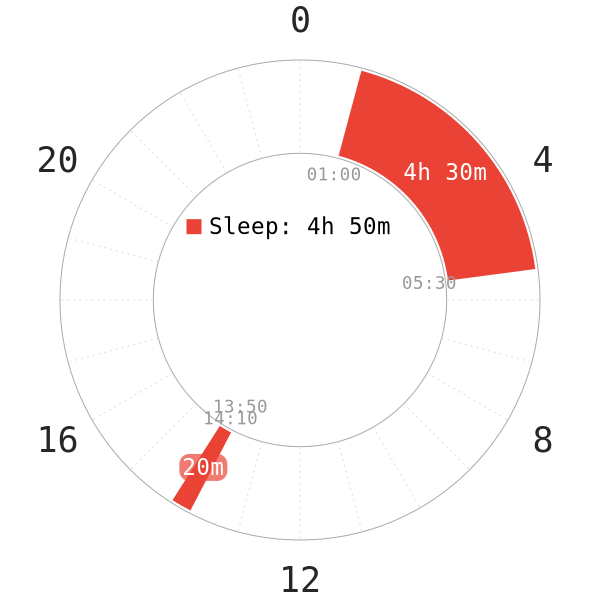
E1-shortened is an extreme variant. The concept is the same as the standard variant except the removal of 1 full core cycle. Up to date, there has been limited success with the shortened version. From the limited total sleep, all success so far comes from short sleepers (~6h monophasic duration).
There are some unique features that E1-shortened offers compared to more radically reduced schedules:
- The wake period between two sleep blocks opens up room for a lot of activities. This is also critical for short sleepers with regular 9-to-5 jobs or school schedule.
- Because short sleepers can stay awake longer than average sleepers, their E1 nap does not have to be ~6-9h away from the core. This distance can be quite a bit longer without causing excessive tiredness (barring ongoing adaptation). If they cannot afford a nap during noon break, their E1 nap can be right after school or work.
- This version can give some amount of sleep reduction even for short sleepers, while requiring only two sleep sessions per day. Thus, it is much more convenient to schedule than certain extreme schedules with more than 3-4 sleep sessions each day.
- So far, mostly the 4h and 4.5h cores have reported some rare success. Because of the extreme difficulty of this variant, average sleepers should not attempt them.
- Short sleepers often have less REM duration than average sleepers; therefore, their statistically-likely REM period may not be at the 4.5-5h mark like average sleepers.
- Middling core durations such as 4h can work for certain sleepers; however, the 90m rule is more recommended.
- Other E1 variants listed in this page can also suit short sleepers regarding different sleep distributions; however, short sleepers can mix and match their nap and core placement to optimize their adaptation outcome.
E1-extended
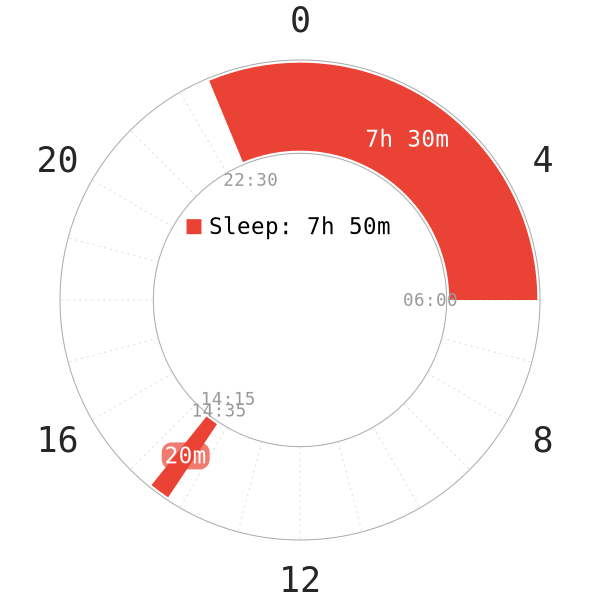
- This version is the usual recommendation for sleepers who are younger than 16 years old, or even adults with a physically active lifestyle.
- Furthermore, individuals with high sleep requirements or scheduling constraints (e.g, long wake gap from 9 AM to 5 PM) can make use of this scheduling. A 9-hour monophasic sleeper can still enjoy a decent amount of sleep cut with a 7.5h core.
- The extended version allows for more versatility in the placement of nap times. Because most, if not all of the vital sleep stages are from in the core, the nap mostly serves to give some alertness boost (NREM2) or probably some amount of REM sleep to improve learning and memory. It is then possible to take the nap at later hours of the day (e.g, 4-5:30 PM).
The possible difficulties of E1 are as follows:
- It may take more time to effectively nap than on other reducing schedules as sleep pressure is lower.
- The adaptation to E1-extended may last just as long as the regular version, albeit much milder. This includes a possibility of a silent Stage 3. What this means is no signs of severe sleep deprivation symptoms or crippled productivity as seen on other more reducing schedules.
- Picking this variant as a result can maximize daily performances (physical and cognitive) at work and/or school even during adaptation.
Non-reducing E1
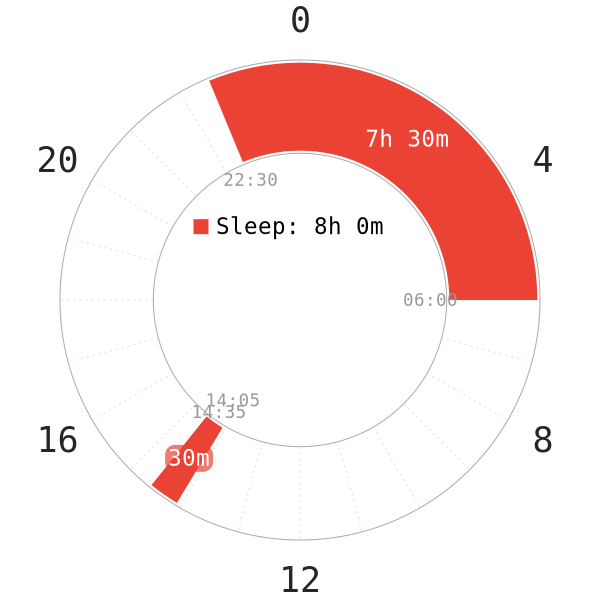
If needed to be non-reducing, Everyman 1 can abuse various sleep mechanics:
- The nap can last anywhere from 10m to ~30m since E1 has a short daytime nap (not to be confused with Siesta, whose daytime sleep is often longer than ~50m).
- The nap duration can change from day to day.
- It is also possible to start the nap at different time each day.
- The core duration is not fixed and sleepers should rely on natural wakes for both sleep blocks.
- This scheduling variant can have consistent or slightly different sleep times each day from day 1. The core should not be more flexible than a 1h window when adapting. This means the window should limit to sleeping ~1h later or earlier than the original time to keep a consistent circadian rhythm).
- It is necessary to recognize the time they are naturally tired or drowsy in the day to place the nap accordingly; if the timetable does not allow for a large flexibility of the nap, then a smaller nap window would be preferred. Most importantly, it is important to carefully plan late naps (past ~5-6 PM) or avoid them altogether. They may interfere with the core at night, because total sleep time is already high.
Recently, there has been some success of this variant with very young teenagers or people with high sleep requirements who pursue the safest way to partake in polyphasic sleeping. They have the option for a daytime nap to train napping skills.
This usually serves as groundwork for them to move to a more difficult schedule when time allows. Compared to Siesta, the short daytime nap of E1 is easy to schedule around meal times and social events.
Lifestyle Considerations
Research
Curious about a research paper for Everyman 1? Look no further than here!
Community Assessment
Everyman 1 is overall a powerful biphasic schedule to prepare beginners for more advanced schedules. In addition, it does benefit a vast array of lifestyles.
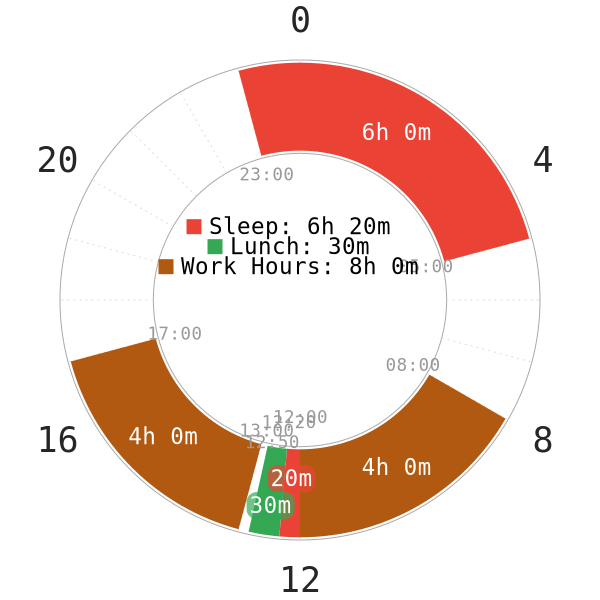
- Its biphasic nature allows for long wake gaps between the nap and the core. The nap can fit into the most common 9-to-5 jobs nowadays.
- The nap can also be at around noon in between any breaks or after work, before an exercising session.
- It is easy to sustain the schedule long term; it is usually more difficult for daily commitments to interrupt a short nap. After adaptation, the nap can become flexible by up to 2h (earlier and later than the original sleep time). The degree of flexibility can potentially be more, but more data is needed.
- It is necessary to pay attention to the nap even after adaptation. The nap is very short and time passes very quickly. It is also easy to skip the nap on a lot of occasions.
- While it is possible to skip the nap if inconvenient (after adapted), this is not optimal. Rather, it is better to lie down and assume sleep for 20m instead.
- Being adapted to E1 is an achievement for any beginners.
Main author: GeneralNguyen
Page last updated: 8 April 2021

